I’ve been working with walnut wood for decades and never had a problem. Most wood once dry tends to lock in any chemical, obviously oak leaches tannins when wet but have you ever tasted tannins off an oak cutting board on your food? I believe juglone is a plant suppressant and don’t know of any studies that says the minuscule amount in the wood inhibit human growth, also when I spread walnut sawdust in the weeds it doesn’t impact the growth of the weeds.
You are using an out of date browser. It may not display this or other websites correctly.
You should upgrade or use an alternative browser.
You should upgrade or use an alternative browser.
Basket press advice...
- Thread starter Bliorg
- Start date

Help Support Winemaking Talk - Winemaking Forum:
This site may earn a commission from merchant affiliate
links, including eBay, Amazon, and others.
toadie
Member
- Joined
- Nov 28, 2020
- Messages
- 93
- Reaction score
- 86
I agree the miniscule amount that might leach out while pressing grapes or cutting food is probably not a major cause for concern but... I really do battle the roots in the garden, especially around the tomatoes. Also horses have problems with their hooves and respiration when black walnut sawdust/shavings are used for bedding.
balatonwine
The Verecund Vigneron
Also horses have problems with their hooves and respiration when black walnut sawdust/shavings are used for bedding.
Am glad I only have the Capthian Walnut. It still has hydrojuglone, but not so much as American Black Walnut. Leaves compost fine (after 6 weeks in a hot compost bed, any toxicity is over, and grow lots of vegetables in such compost without issues). And might tasty nuts. Ergo .. Not all walnuts (or walnut wood) are created (or compost, or should be judged) equal.
Last edited:
FWIW, I've seen references that the irritants and allergens in walnut are almost entirely (or entirely, depending on source) restricted to the nuts, leaves, and roots. I've also read that the sensitivity to the dust is a different reaction than to juglone. YMMV.
All this good discussion aside, regardless of the wood that ultimately gets used, it will be finished with a hardening, food safe finish, which will be maintained as needed. So the contact between liquid and wood will be essentially nil.
All this good discussion aside, regardless of the wood that ultimately gets used, it will be finished with a hardening, food safe finish, which will be maintained as needed. So the contact between liquid and wood will be essentially nil.
Okay, question for those of you with experience: The staves on my press originally were tapered back-to-front by about 1/8"+:
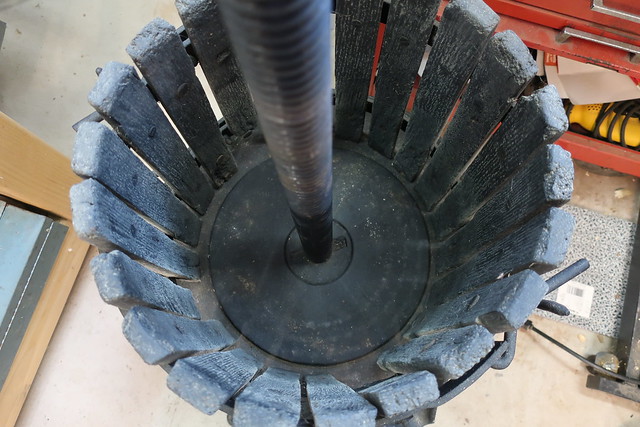 IMG_2608 by Scott, on Flickr
IMG_2608 by Scott, on Flickr
I've seen other, newer presses that had no taper at all. Does this matter either way? I have a bit at MLCS that I was going to buy to cut that but not sure now if it's necessary.
Thoughts?
 IMG_2608 by Scott, on Flickr
IMG_2608 by Scott, on FlickrI've seen other, newer presses that had no taper at all. Does this matter either way? I have a bit at MLCS that I was going to buy to cut that but not sure now if it's necessary.
Thoughts?

$14.80
$24.00
The Geography of Wine: How Landscapes, Cultures, Terroir, and the Weather Make a Good Drop
Amazon.com

$213.50 ($213.50 / Count)
Wine Ingredient Kit - En Primeur Winery Series - South African Sauvignon Blanc
Bridgeview Beer and Wine Supply

$6.99 ($0.35 / Count)
Red Supply Solution Wine Grape 20 Seeds - Vitis Vinifera, Organic Fresh Seeds Non GMO, Indoor/Outdoor Seed Planting for Home Garden
ORGINBUD LLC

$7.98
100 Pcs Plastic Plant Clips, Reusable Secured Plant Support Clips,Plant Fixing Clips,Trellis Clips,Gardeninging Supplies,Grape Vine Clips for String Trellis
Kelinfong US【 7-15 Days Delivery】

$0.01
100 Pcs Plastic Plant Clips, Reusable Secured Plant Support Clips,Plant Fixing Clips,Trellis Clips,Gardeninging Supplies,Grape Vine Clips for Support
Kelinfong US【 7-15 Days Delivery】

$74.99 ($74.99 / Count)
Delirious Trembles Belgian Golden Strong Ale, Beer Making Extract Kit
Boomchugalug

$24.77
$40.00
The Sommelier's Atlas of Taste: A Field Guide to the Great Wines of Europe
Amazon.com
Good call! I’ll order the bit. Thanks for the input.My press is old and the staves are also tapered. I'm not sure how much of a difference it really makes when in operation, but I believe it makes cleaning easier.
When I built a basket I tapered the staves because that left a smaller flat of wood to be in contact with the hoop. When I tried a piece that wasn't tapered, only the corners of the wood would rest on the hoop. Tapering the staves made a better circle on the outside.
Last edited:
Not meaning to stir the pot, but am gearing up to (hopefully) finish this project in the next month or so. Have been trolling FB Marketplace for lumber to rebuild the basket. No one local has any quartered white oak, which I'd love from an aesthetics view (and fuming is fun). Plenty of maple, which is what I'll probably go with in the end, though I don't like the look as much, especially with other viable, but better looking, options. Found a guy in FLA that would ship a box of 2+" wide walnut cutoffs, which would work for this. And I'm pretty sure I have enough walnut in the pile in the garage to finish this anyway. So, I was revisiting the whole "food safe finish" topic, should I actually use walnut (which I still think could be used raw, as is done in cutting boards). Anyway, over t' Woodcentral (a great site in its own right) I found the following article, with contributions by Bob Flexnor and Michael Desdner (Link to articles - I cannot paste them in without exceeding the maximum character limit here: Food-Safe Finishes). Great information to have, and fuel to draw your own informed conclusions.
Walnut is a fairly soft wood, I would not buy factory equipment with walnut.
oak is chosen for strength, hickory is another strong wood, maple has a tight grain and is preferred on surfaces as food cutting boards and even countertops.
I am tempted to say every community has a high school with a shop that has the tools to make any shape you would want, and there is a good chance the exact species wood you want. A second source for small quantity shapes is a cabinet shop (as in kitchen cabinets).
I am also rebuilding an old press, ,,, for function the basket will probably be done with perforated stainless steel which came off Craig’s list.
oak is chosen for strength, hickory is another strong wood, maple has a tight grain and is preferred on surfaces as food cutting boards and even countertops.
I am tempted to say every community has a high school with a shop that has the tools to make any shape you would want, and there is a good chance the exact species wood you want. A second source for small quantity shapes is a cabinet shop (as in kitchen cabinets).
I am also rebuilding an old press, ,,, for function the basket will probably be done with perforated stainless steel which came off Craig’s list.
Not meaning to stir the pot, but am gearing up to (hopefully) finish this project in the next month or so. Have been trolling FB Marketplace for lumber to rebuild the basket. No one local has any quartered white oak, which I'd love from an aesthetics view (and fuming is fun). Plenty of maple, which is what I'll probably go with in the end, though I don't like the look as much, especially with other viable, but better looking, options. Found a guy in FLA that would ship a box of 2+" wide walnut cutoffs, which would work for this. And I'm pretty sure I have enough walnut in the pile in the garage to finish this anyway. So, I was revisiting the whole "food safe finish" topic, should I actually use walnut (which I still think could be used raw, as is done in cutting boards). Anyway, over t' Woodcentral (a great site in its own right) I found the following article, with contributions by Bob Flexnor and Michael Desdner (Link to articles - I cannot paste them in without exceeding the maximum character limit here: Food-Safe Finishes). Great information to have, and fuel to draw your own informed conclusions.
Last edited:
balatonwine
The Verecund Vigneron
Have been trolling FB Marketplace for lumber to rebuild the basket.
Many baskets are made of Beech. A very neutral wood regarding flavor. Requires no finish. Can be used natural and raw.
balatonwine
The Verecund Vigneron
I am also rebuilding an old press, ,,, for function the basket will probably be done with perforated stainless steel
I have been thinking of also replacing the wood staves with stainless steel. If but nothing else, to save my back. Lifting the baskets on a #55 press is getting old....
The only issues I have not solved in such a conversion is how to keep a custom SS basket from scratching up the paint on the tray, and yet allowing press juice to flow as well as through wood staves at the bottom. I have some ideas, but none are fully formed in my mind yet.

Cap Puncher
Senior Member
- Joined
- Feb 6, 2021
- Messages
- 186
- Reaction score
- 273
I’m currently finishing a #45 press that had water damage on some of the staves. They are beech. I am actually using Ash because the only beech board at my local hardwood lumber yard, looked pretty bad.
While refinishing, i used a 12 gallon stainless basket for smaller batches. It was an insert that came with a stainless 84L pot I bought for fermentation. It was for crawfish boiling but worked great as a press basket. I cut a hole and used silicone tubing to protect the cut/paint. You could use silicone tubing at the bottom of the stainless basket to protect the paint on the press.
FYI, I’m using EZ-Do for a finish coating on my beech/Ash staves. Just did them a couple nights ago.
The top pic are the beech, 2nd pic are the Ash. Bottom pic is the stainless basket on the #45 press base (from an apple press this year)
While refinishing, i used a 12 gallon stainless basket for smaller batches. It was an insert that came with a stainless 84L pot I bought for fermentation. It was for crawfish boiling but worked great as a press basket. I cut a hole and used silicone tubing to protect the cut/paint. You could use silicone tubing at the bottom of the stainless basket to protect the paint on the press.
FYI, I’m using EZ-Do for a finish coating on my beech/Ash staves. Just did them a couple nights ago.
The top pic are the beech, 2nd pic are the Ash. Bottom pic is the stainless basket on the #45 press base (from an apple press this year)
Attachments
Last edited:
balatonwine
The Verecund Vigneron
I am actually using Ash
Ash, also a good wood to use. Maple is also a wood I have see others recommend.
You could use silicone tubing at the bottom of the stainless basket to protect the paint on the press.
Good idea.
Yes, I have thought of that. But since the juice actually flows down, till it hits the tray, then goes horizontal, the tubing would need to be added in pieces to allow spaces and horizontal flow from the tray. And having to remove, clean and replace a few dozen little tubing pieces seems like too much work (since I do maybe 10 different pressing a year some days apart which requires full dismantle and cleaning of everything). I thought about dipping the basket in liquid latex, and cutting holes, or expoxing in said silicone tubing, and other ideas. Basically, I simply have not decided or worked out all the +/- issues of each idea in my mind yet.
But always happy to get input/ideas from others.
Last edited:
@Cap Puncher always like a photo
I have several SS pots (baskets) but the biggest so far is a ten inch.

I will put a plate with holes under the basket/ cake, or a plastic mesh (circle cut out of a polyethylene cutting board/ mesh that came with a pizza delivery box.) PE would prevent scratches.
I also have several sizes of PVC pipe with holes drilled on the side that I have used as press baskets. My next change will be to figure out a way to hinge or pin the PVC to break the cake out.
Not asked, but I put acrylic rounds on top of the cake and under the wood blocks, it seems easier to clean than wood.
I have several SS pots (baskets) but the biggest so far is a ten inch.

I will put a plate with holes under the basket/ cake, or a plastic mesh (circle cut out of a polyethylene cutting board/ mesh that came with a pizza delivery box.) PE would prevent scratches.
I also have several sizes of PVC pipe with holes drilled on the side that I have used as press baskets. My next change will be to figure out a way to hinge or pin the PVC to break the cake out.
Not asked, but I put acrylic rounds on top of the cake and under the wood blocks, it seems easier to clean than wood.
Cap Puncher
Senior Member
- Joined
- Feb 6, 2021
- Messages
- 186
- Reaction score
- 273
[QUOTE="Rice_Guy, post: 813249, member: 30637
Not asked, but I put acrylic rounds on top of the cake and under the wood blocks, it seems easier to clean than wood.
[/QUOTE]
I like the idea of acrylic rounds on the cake. I did 2 in Ash half moons with 2 coats of EZ-do that I custom cut for my SS basket. They work well but even after 2 coats of the EZ-do and a month dry time, color from pressing still seeped in and it was a pain to clean them. Acrylic is a good idea
Not asked, but I put acrylic rounds on top of the cake and under the wood blocks, it seems easier to clean than wood.
[/QUOTE]
I like the idea of acrylic rounds on the cake. I did 2 in Ash half moons with 2 coats of EZ-do that I custom cut for my SS basket. They work well but even after 2 coats of the EZ-do and a month dry time, color from pressing still seeped in and it was a pain to clean them. Acrylic is a good idea
Attachments
Thanks for the thoughts, folks.
I'm pretty sure the wood that was on the press originally, which was damaged, rotted, and falling apart, was beech. The mills local to me (except one) only carry local hardwoods - beech t'ain't one of them. The other mill only carries European beech, which is WAY out of my bottom feeder price range.
Yes, walnut is softer than QSWO. And sugar/hard maple (not soft maple). Is it too soft for this service? I doubt it. That's my opinion, based on working a lot of walnut. YMMV. I'm not interested an a stainless basket, but I'm also not planning on doing 20 presses a season. Yet. Again, YMMV.
The acrylic rounds are a good idea. That said, my press plates are cast, but perforated similarly:
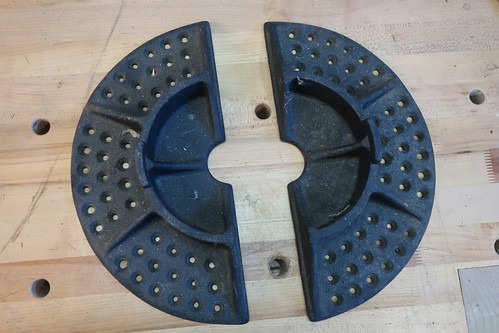
I'm as yet undecided as to which wood I'll end up using. Walnut is my favorite wood to work, all time. Ash is second. Fuming oak appeals to my love of woodworking and of chemistry. Maple is probably the most pragmatically appropriate wood for this (lacking beech locally); it's dull as Oprah to look at. But I may still end up with it. Like I've said - I look at this as a combination of a suitable wood, and something that I'll be happy with, and right or wrong, it's not solely a functional decision for me.
Process is a large part of the enjoyment for me. I'm enjoying every aspect of this project, including these design decisions along the way. I appreciate everyone's input about all of this - I learn a lot, and it spurs me to do more investigation. Thanks folks.
I'm pretty sure the wood that was on the press originally, which was damaged, rotted, and falling apart, was beech. The mills local to me (except one) only carry local hardwoods - beech t'ain't one of them. The other mill only carries European beech, which is WAY out of my bottom feeder price range.
Yes, walnut is softer than QSWO. And sugar/hard maple (not soft maple). Is it too soft for this service? I doubt it. That's my opinion, based on working a lot of walnut. YMMV. I'm not interested an a stainless basket, but I'm also not planning on doing 20 presses a season. Yet. Again, YMMV.
The acrylic rounds are a good idea. That said, my press plates are cast, but perforated similarly:

I'm as yet undecided as to which wood I'll end up using. Walnut is my favorite wood to work, all time. Ash is second. Fuming oak appeals to my love of woodworking and of chemistry. Maple is probably the most pragmatically appropriate wood for this (lacking beech locally); it's dull as Oprah to look at. But I may still end up with it. Like I've said - I look at this as a combination of a suitable wood, and something that I'll be happy with, and right or wrong, it's not solely a functional decision for me.
Process is a large part of the enjoyment for me. I'm enjoying every aspect of this project, including these design decisions along the way. I appreciate everyone's input about all of this - I learn a lot, and it spurs me to do more investigation. Thanks folks.
PROGRESS!!!
After way too much thought, interruptions, and general stalling out, I got some uninterrupted shop time today and milled the staves.
After deciding to use what I had on hand, rather than spend more money and have an overall accumulation in the shop, I landed on some really old cherry, some of which has been kicking around out there for over 25 years.
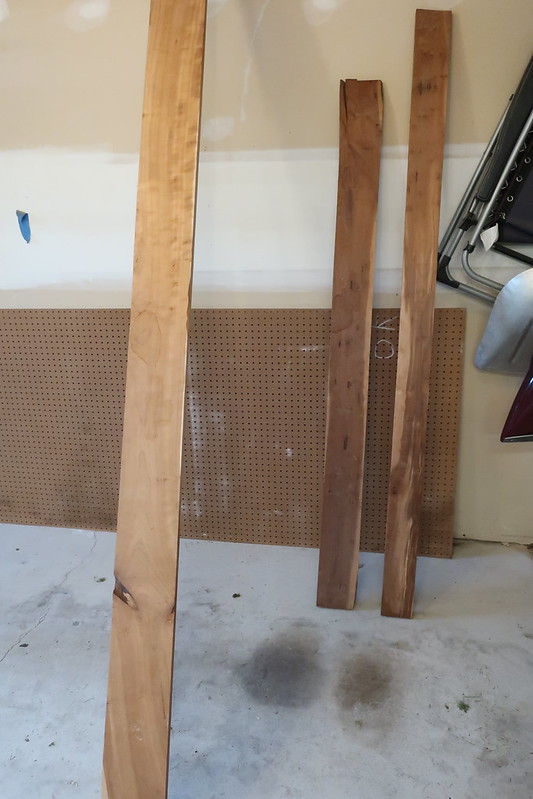
I only ended up using the 11' board and part of the shorter board.
Cut to rough length:
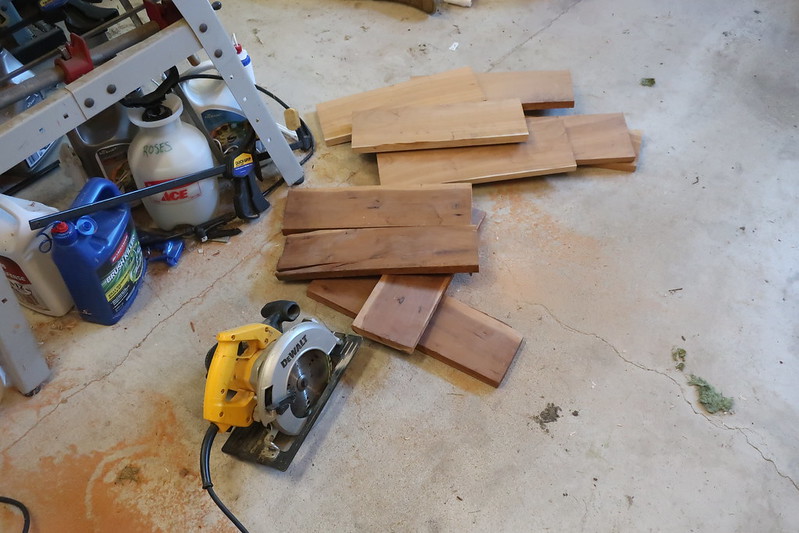
Ripped on the table saw to just strong of 1-7/8" wide, matching the original staves:
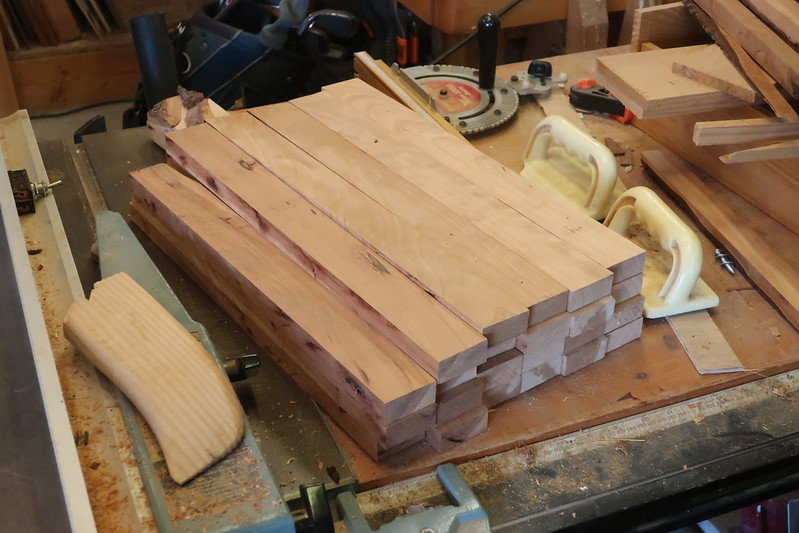
Trimmed to final length - 16", again matching the original. I considered adding a couple inches overall length, but decided this is plenty of capacity, which honestly is likely more than I'll ever use.
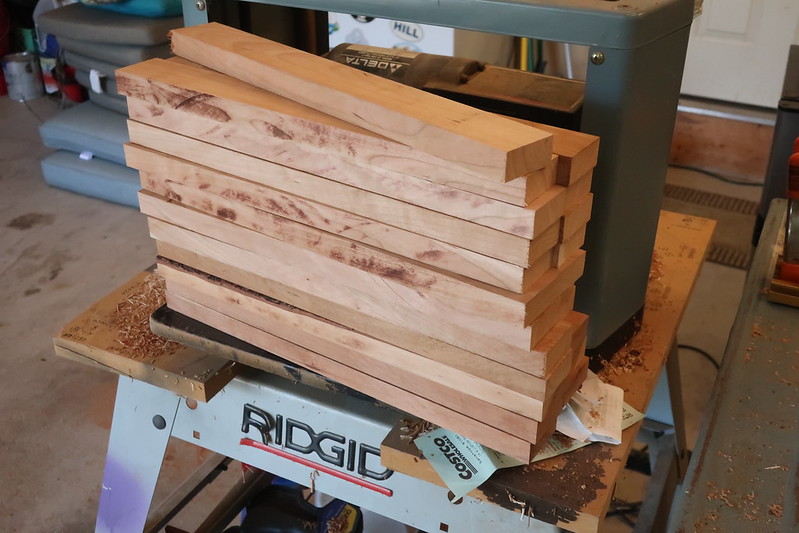
The original staves were tapered about 1/8" each side back-to-front. I wanted to match that, and the easiest way seemed to be a 15 degree chamfer bit (from MLCS).
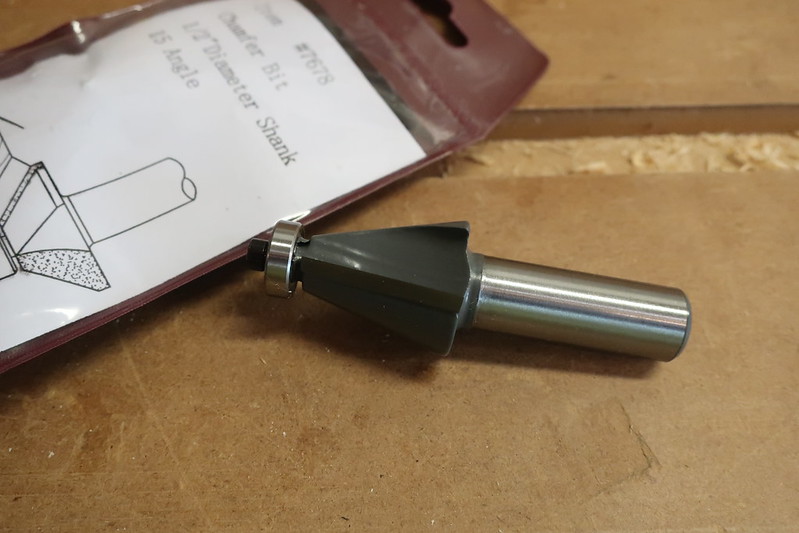
The edges were cut on a horizontal router table. Worked a treat.
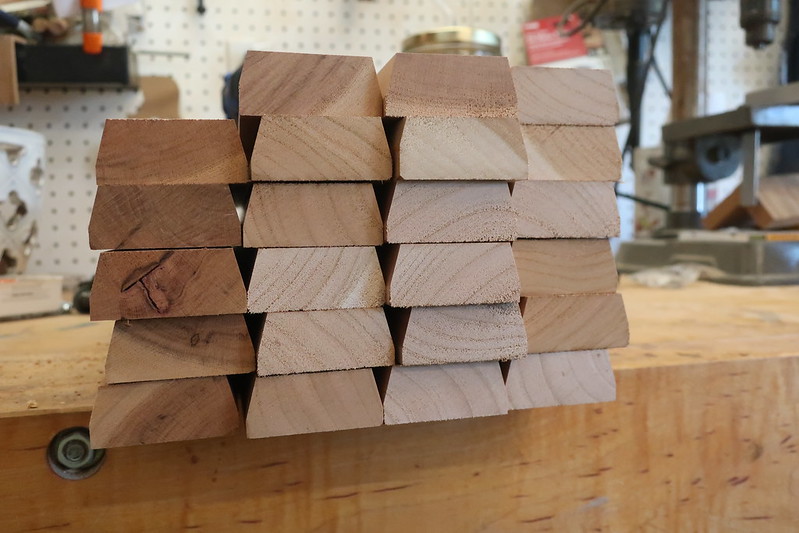
There's a flat to each edge because 15 degrees wasn't quite steep enough, and routing the entire thickness would have resulted in too much material being taken off.
The table saw left a pretty sharp edge, which seemed like a hazard. Broke the edges with a 45 degree chamfer bit. Total router table work was 16 cuts per piece.
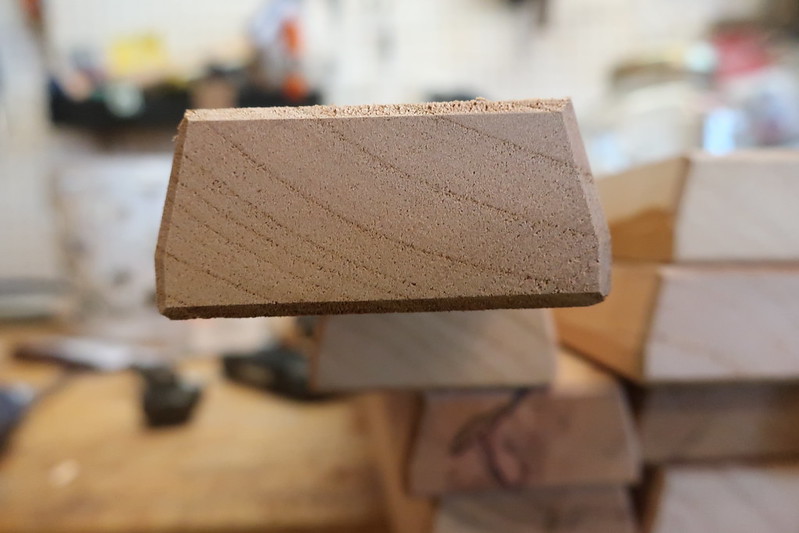
Finished pieces:
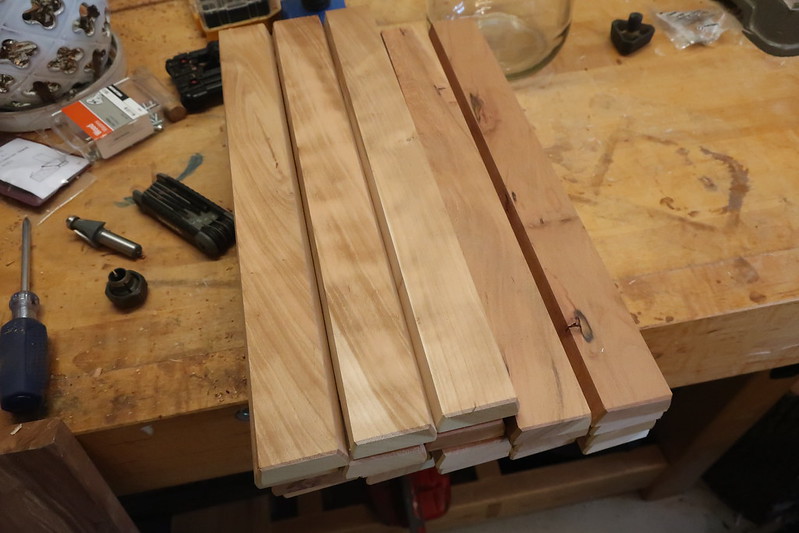
I ended up with 23, need 22. A spare seemed like it was worth it.
Now that I know the final thickness of the pieces I can order my hardware. Once I get it I'll set up a jig on the drill press and drill the holes for the screws. In the meantime I'll figure out a finish for the wood. Any luck I'll be using this yet this year.
Feels good to get off dead zero with this project.
After way too much thought, interruptions, and general stalling out, I got some uninterrupted shop time today and milled the staves.
After deciding to use what I had on hand, rather than spend more money and have an overall accumulation in the shop, I landed on some really old cherry, some of which has been kicking around out there for over 25 years.

I only ended up using the 11' board and part of the shorter board.
Cut to rough length:

Ripped on the table saw to just strong of 1-7/8" wide, matching the original staves:

Trimmed to final length - 16", again matching the original. I considered adding a couple inches overall length, but decided this is plenty of capacity, which honestly is likely more than I'll ever use.

The original staves were tapered about 1/8" each side back-to-front. I wanted to match that, and the easiest way seemed to be a 15 degree chamfer bit (from MLCS).

The edges were cut on a horizontal router table. Worked a treat.

There's a flat to each edge because 15 degrees wasn't quite steep enough, and routing the entire thickness would have resulted in too much material being taken off.
The table saw left a pretty sharp edge, which seemed like a hazard. Broke the edges with a 45 degree chamfer bit. Total router table work was 16 cuts per piece.

Finished pieces:

I ended up with 23, need 22. A spare seemed like it was worth it.
Now that I know the final thickness of the pieces I can order my hardware. Once I get it I'll set up a jig on the drill press and drill the holes for the screws. In the meantime I'll figure out a finish for the wood. Any luck I'll be using this yet this year.
Feels good to get off dead zero with this project.
Very nice, I enjoyed making my press
Cap Puncher
Senior Member
- Joined
- Feb 6, 2021
- Messages
- 186
- Reaction score
- 273
I refurbished a #45 press last year and replace 1/2 of the staves. I used
E-Z DO on the staves for the finish. It is a food contact safe polyurethane. It worked well.
E-Z DO on the staves for the finish. It is a food contact safe polyurethane. It worked well.
















































